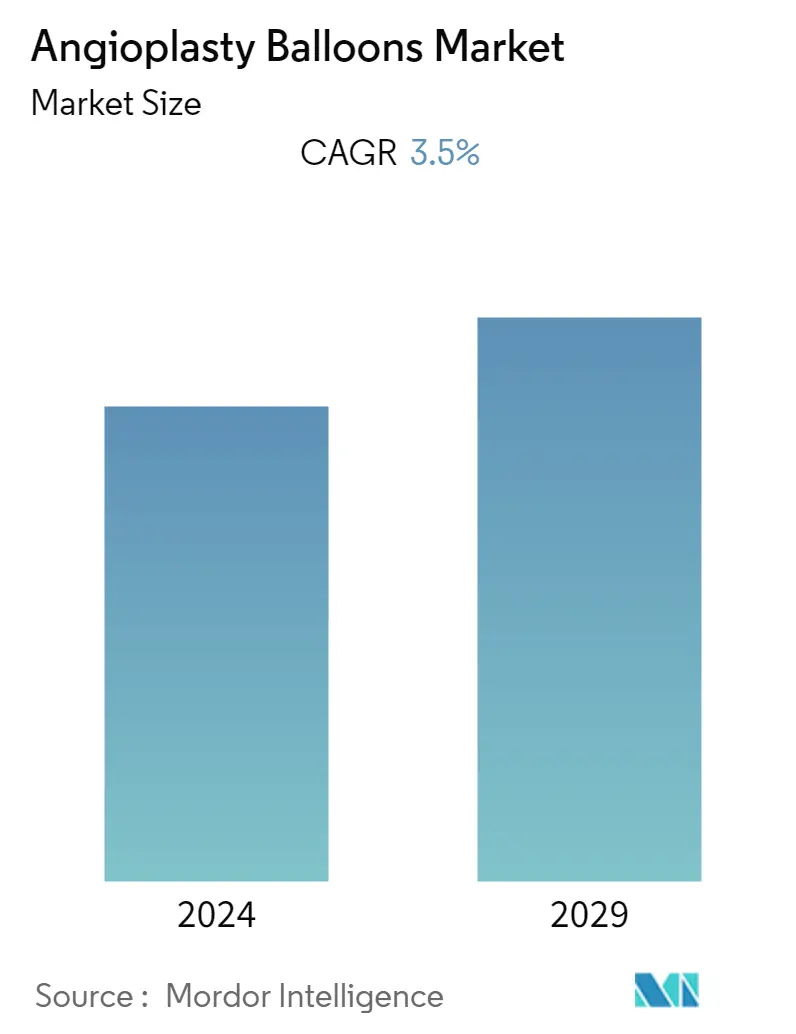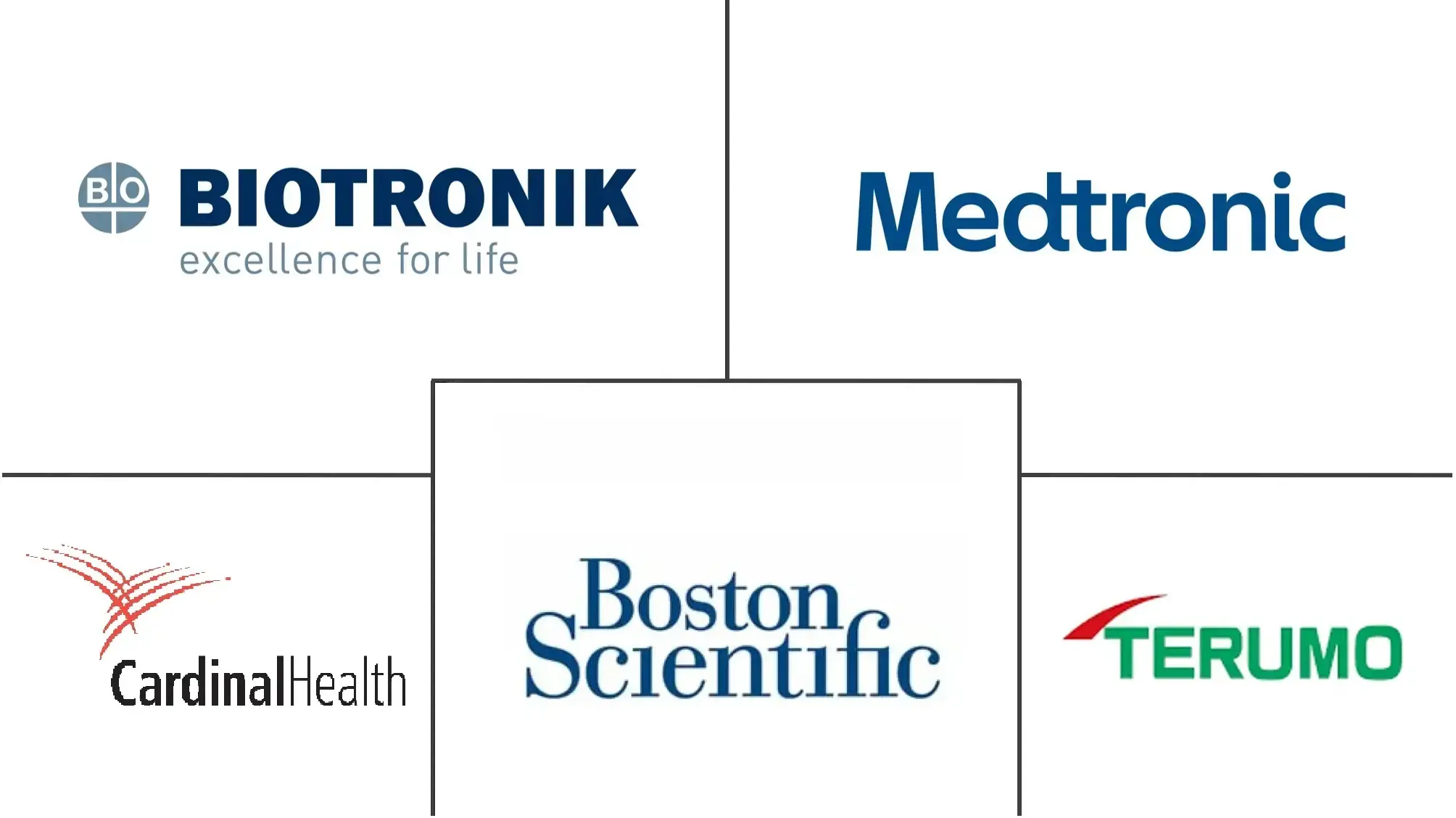Market Size of Angioplasty Balloons Industry

| Study Period | 2019 - 2029 |
| Base Year For Estimation | 2023 |
| CAGR | 3.50 % |
| Fastest Growing Market | Asia Pacific |
| Largest Market | North America |
| Market Concentration | Low |
Major Players
*Disclaimer: Major Players sorted in no particular order |
Angioplasty Balloons Market Analysis
The angioplasty balloons market was valued at about USD 2639.25 million in the current year and is expected to reach USD 3343.12 million by the end of the forecast period, registering a CAGR of nearly 3.5% over the forecast year.
The COVID-19 pandemic has had a significant impact on interventional cardiology procedures like percutaneous coronary intervention (PCI), which often involves the use of angioplasty balloons due to prioritisation of resources, the implementation of additional safety measures, delays in procedures, and changes in patient management. For instance, according to an article published in PLOS ONE, in September 2022, during the COVID-19 pandemic, there was a reduction in percutaneous coronary intervention (PCI) volumes and higher risk-adjusted mortality. COVID-19-positive patients undergoing PCI had a markedly higher prevalence of baseline clinical and presentation features indicative of higher severity of illness. Thus, the COVID-19 pandemic has had an adverse impact on the market's growth in its initial phase. However, as healthcare systems adapted to the new normal, there was a recovery in the angioplasty balloon market. The resumption of elective procedures and the gradual return to normalcy are expected to drive the demand for angioplasty balloons in the post-pandemic period.
The significant factors for the growth of the angioplasty balloons market include the increasing burden of cardiovascular diseases requiring angioplasty, such as atherosclerosis or coronary artery disease. For instance, according to the Centers for Disease Control and Prevention (CDC) update in March 2023, coronary heart disease is the most common type of heart disease; about 1 in 20, 5% of adults age 20 and older, have coronary artery disease. Furthermore, according to the British Heart Foundation's Report published in July 2022, 7.6 million people in the United Kingdom lived with heart and circulatory diseases in 2021, of which 4 million were men and 3.6 million were women. Therefore, the increasing burden of heart disease is anticipated to boost the usage of angioplasty balloons, driving market growth over the forecast period.
Additionally, increasing preference for minimally invasive procedures is expected to drive market growth as it involves using small incisions and angioplasty balloons to navigate and treat the affected blood vessels. For instance, an article by the National Library of Medicine published in January 2023 reported that an annual volume of more than three million minimally invasive surgery cases was calculated in the United States. Angioplasty, a minimally invasive procedure, offers several advantages, such as reduced trauma to the body, shorter hospital stays, faster recovery times, and fewer complications. Hence, with an increasing preference for minimally invasive procedures due to their advantage, the demand for angioplasty balloons is expected to increase, thereby driving market growth.
Moreover, various initiatives taken by key players, such as product launches, mergers, acquisitions, and partnerships to increase the product footprint, are expected to boost the market's growth during the forecast period. For instance, in June 2022, Royal Philips reported the results from the Tack Optimized Balloon Angioplasty (TOBA) II below-the-knee (BTK) clinical trial, demonstrating that the Philips endovascular system - Tack (4F) approved by the U.S. FDA, provides a sustained treatment effect and positive impact on quality of life for patients with critical limb ischemia (CLI), a severe stage of peripheral arterial disease (PAD), out to three years of clinical follow-up.
Hence, the angioplasty balloons market is anticipated to grow over the forecast period due to the increasing burden of cardiovascular diseases requiring angioplasty balloons, increasing preference for minimally invasive procedures, and ongoing research and development activities. However, high costs and complications associated with angioplasty procedures are some factors hindering the market's growth.
Angioplasty Balloons Industry Segmentation
As per the scope of the report, an angioplasty balloon, also referred to as a balloon catheter or a dilatation catheter, is a medical device used during an angioplasty operation. An angioplasty is a minimally invasive technique used to open up or enlarge blood channels that are clogged or restricted, often in the peripheral arteries or the coronary arteries of the heart. The Angioplasty Balloons Market is Segmented by Product Type (Normal Balloons, Cutting/Scoring Balloons, and Drug-Eluting Balloons), Application (Coronary Angioplasty and Peripheral Angioplasty), End User (Hospitals, Ambulatory Surgical Centers, and Other End Users), and Geography (North America, Europe, Asia-Pacific, Middle East and Africa, and South America). The Market report also covers the estimated market sizes and trends of 17 countries across major regions globally. The report offers values (in USD million) for the above segments.
| By Product Type | |
| Normal Balloons | |
| Cutting/Scoring Balloons | |
| Drug Eluting Balloons |
| By Application | |
| Coronary Angioplasty | |
| Peripheral Angioplasty |
| By End User | |
| Hospitals | |
| Ambulatory Surgical Centers | |
| Other End Users |
| Geography | ||||||||
| ||||||||
| ||||||||
| ||||||||
| ||||||||
|
Angioplasty Balloons Market Size Summary
The angioplasty balloons market is poised for growth, driven by the increasing prevalence of cardiovascular diseases such as atherosclerosis and coronary artery disease, which necessitate angioplasty procedures. The market has shown resilience following the disruptions caused by the COVID-19 pandemic, which initially impacted interventional cardiology procedures due to resource prioritization and safety measures. As healthcare systems have adapted, the demand for angioplasty balloons has begun to recover, supported by the resumption of elective procedures. The preference for minimally invasive procedures, which offer benefits like reduced trauma and faster recovery, is also contributing to market expansion. Additionally, ongoing research and development activities, along with strategic initiatives by key players, are expected to further bolster market growth over the forecast period.
The drug-eluting balloon segment is anticipated to experience robust growth, fueled by the rising incidence of peripheral and coronary artery diseases. These balloons are particularly effective in delivering medication directly to the site of blockage, enhancing treatment efficacy and reducing restenosis risk. The aging population, which is more susceptible to cardiovascular conditions, is expected to drive demand in this segment. North America is projected to hold a significant share of the market, supported by a strong healthcare infrastructure and a high incidence of cardiovascular diseases. Key market players are actively engaging in product development and strategic partnerships to enhance their market presence, further driving regional growth. The market remains fragmented, with several prominent players maintaining a dominant position, indicating a competitive landscape with ongoing innovations and collaborations.
Angioplasty Balloons Market Size - Table of Contents
-
1. MARKET DYNAMICS
-
1.1 Market Overview
-
1.2 Market Drivers
-
1.2.1 Increasing Burden of Cardiovascular Diseases Requiring Angioplasty
-
1.2.2 Increasing Preference for Minimally Invasive Procedures and Technological Advancements
-
-
1.3 Market Restraints
-
1.3.1 High Costs Associated with the Procedure
-
1.3.2 Complications Associated with Angioplasty Procedures
-
-
1.4 Porter's Five Forces Analysis
-
1.4.1 Threat of New Entrants
-
1.4.2 Bargaining Power of Buyers/Consumers
-
1.4.3 Bargaining Power of Suppliers
-
1.4.4 Threat of Substitute Products
-
1.4.5 Intensity of Competitive Rivalry
-
-
-
2. MARKET SEGMENTATION (Market Size by Value - USD million)
-
2.1 By Product Type
-
2.1.1 Normal Balloons
-
2.1.2 Cutting/Scoring Balloons
-
2.1.3 Drug Eluting Balloons
-
-
2.2 By Application
-
2.2.1 Coronary Angioplasty
-
2.2.2 Peripheral Angioplasty
-
-
2.3 By End User
-
2.3.1 Hospitals
-
2.3.2 Ambulatory Surgical Centers
-
2.3.3 Other End Users
-
-
2.4 Geography
-
2.4.1 North America
-
2.4.1.1 United States
-
2.4.1.2 Canada
-
2.4.1.3 Mexico
-
-
2.4.2 Europe
-
2.4.2.1 Germany
-
2.4.2.2 United Kingdom
-
2.4.2.3 France
-
2.4.2.4 Italy
-
2.4.2.5 Spain
-
2.4.2.6 Rest of Europe
-
-
2.4.3 Asia-Pacific
-
2.4.3.1 China
-
2.4.3.2 Japan
-
2.4.3.3 India
-
2.4.3.4 Australia
-
2.4.3.5 South Korea
-
2.4.3.6 Rest of Asia-Pacific
-
-
2.4.4 Middle East and Africa
-
2.4.4.1 GCC
-
2.4.4.2 South Africa
-
2.4.4.3 Rest of Middle East and Africa
-
-
2.4.5 South America
-
2.4.5.1 Brazil
-
2.4.5.2 Argentina
-
2.4.5.3 Rest of South America
-
-
-
Angioplasty Balloons Market Size FAQs
What is the current Global Angioplasty Balloons Market size?
The Global Angioplasty Balloons Market is projected to register a CAGR of 3.5% during the forecast period (2024-2029)
Who are the key players in Global Angioplasty Balloons Market?
Medtronic, Boston Scientific Corporation, Cordis (Cardinal Health), Terumo Corporation and BIOTRONIK are the major companies operating in the Global Angioplasty Balloons Market.

